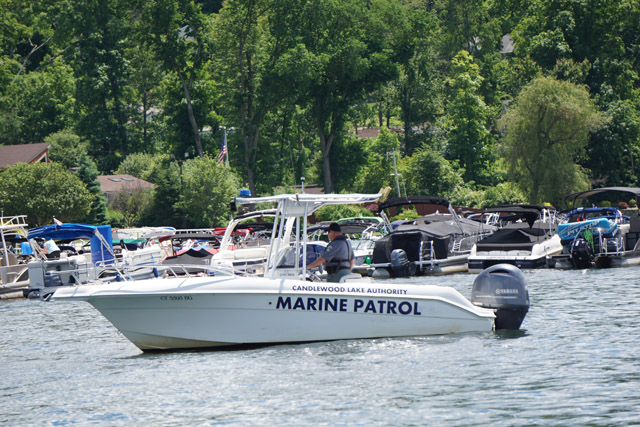
Memorial Day weekend marks the official opening of the summer season. The Candlewood Lake Authority Marine Patrol are the first responders on the entire lake measuring 11 miles long, 2 miles wide, and 65 miles of shoreline spanning five towns. The Patrol strives to ensure all boaters share a safe recreational experience on the lake.
Assistant Chief of Marine Patrol Henry Dyson encourages all boaters to take extra time to do a safety check before they head out on the water. Many boaters have a checklist for opening and closing the boat. Create a personal checklist for essential safety gear.
1. Make sure your drain plugs are in prior to launch.
2. If you aren’t a mechanic, it is a good idea to have a certified boat maintenance professional give your vessel a once-over before you put the boat in the water to make sure it is seaworthy.
3. Be sure you add fresh fuel.
4. 4. Check the expiration date for appropriate safety equipment including your fire extinguisher. If you shake your fire extinguisher you should feel powder moving around inside the device. If the powder is not moving inside have the extinguisher checked by a fire professional or replace it. Instrumentation must be in the green. Check your vessel horn, and if you use one, your air horn.
5. If safety gear is still in its original packaging, open it so you can quickly access it in case of emergency.
6. Check the condition of your life vests, moldy or torn PFD should be replaced. Make sure all PFDs are the appropriate size for each passenger. Add an extra life vest if you pick up a passenger or two – or if you need to be a good citizen for someone in distress.
7. Put a map of the lake in an easily accessible compartment.
8. Make sure you have a charged cell phone and if you have one, an extra battery pack for longer days on the water.
Chief Nick Mellas urges boaters to use caution on the water this early in the season.
1. Seasonal storms can cause large debris to be moved from the islands or personal property into the lake. Be on the lookout for natural obstacles and floating docks or vessels which may come loose around the lake.
2. Water levels are variable, pay careful attention to hidden hazards.
3. Be sure you read and understand what buoy markers are in your line of sight, give hazard buoys a wide berth. Never tie your vessel to a marker buoy.
4. Before May 31, you must wear a life jacket on a canoe, kayak, or paddleboard. Beginning June 1 and through October 31, you must have a life jacket with you, and you should always make sure you wear it.
5. Lake temperatures at this time of year can be in the 55 to 60-degree range. Did you know that there is no difference between lake temperatures of 30 vs 60 degrees Fahrenheit? Hypothermia or cold shock can affect you in a matter of minutes and without a life vest, you may not survive. 50 -60 is the danger zone.
Boat traffic on Candlewood Lake can be particularly busy on the weekends. Boaters are encouraged to be courteous of fellow boaters and to be good citizens of the lake. Marine Patrol will be actively present on the water this summer. Don’t hesitate to stop and ask a question or just to say hello. We will see you on the lake!
What you need to know about operating a vessel on Candlewood Lake
CLA encourages all boaters to take a Boating Safety course and earn a state of CT Safe Boating Certificate (SBC) to keep you – and others – safe on the waters.
1. An SBC is required for Connecticut residents, owners of real estate in Connecticut, and anyone using Connecticut waters more than 60 days a year.
2. Connecticut recognizes certificates from Massachusetts, New Hampshire, New York, and Rhode Island for use on our waters.
3. All personal watercraft (PWC) operators on Connecticut waters must possess a Certificate of Personal Watercraft Operation (CPWO) from DEEP.
Water Skiing Endorsement
Emily’s Law was passed in 2015 in Connecticut for operators of a vessel engaged in water skiing, tubing, or any passengers riding in the wake. Operators:
1. must be at least 16 years old.
2. must hold the appropriate license and/or certificate (see above)
3. must hold a Connecticut DEEP-issued Safe Water Skiing Endorsement.
Anyone who held a valid license and/or certification before October 1, 2015, is grandfathered from the endorsement requirement. If you received an SBC after October 1, 2015, and your SBC doesn’t already include the endorsement, you need to take the two-hour towing endorsement available free of charge through the online sportsman licensing system.
Water Skiing, Wakeboarding, Surfing and Tubing Safety Reminders
1. By law, water skiing is towing anyone behind a vessel under power. This includes surfing, wakeboarding, and tubing.
2. Operators must comply with the DEEP Safe Water Skiing Endorsement regulations.
3. There must be a responsible person at least 12 years of age on board to assist the operator and observe the progress of the person being towed.
4. Towing a passenger behind a vessel is not permitted from one half-hour past sunset to sunrise and when weather conditions limit visibility to less than 10 yards.